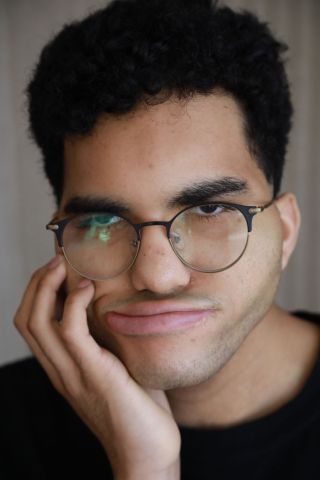Career
The Elephant in the Room: Explaining Facial Difference
New research identifies disclosure styles among people with facial differences.
Posted January 9, 2023 Reviewed by Ekua Hagan
Key points
- Even though it may be obvious, people with facial differences are still expected to disclose or explain their condition to others.
- The disclosure experiences among people with facial differences are largely influenced by whether they feel forced to disclose or not.
- Disclosure styles among people with facial differences range from telling no one to coming out proud.

This post is part 1 of a two-part series.
Much has been said about the benefits and costs of “coming out” when you have a stigmatized yet invisible identity, like being gay or having a mental health condition. But what happens when the stigma is as plain as the nose on your face? New research suggests that people with facial differences or disfigurements also contend with “coming out” by disclosing or explaining their condition. Our study identifies a taxonomy of disclosure types that overlaps with, yet is distinct from, disclosure approaches used by people with invisible stigma.
Facial differences are hypervisible, meaning that people with facial differences are not given the privilege of “civil inattention,” or being an anonymous face in a crowd. For mundane tasks like going to the grocery store, people may want to run in and out quickly in their sweatpants and not be noticed, yet even at times like this they are recognized, stared at, and questioned.
Strangers crave disclosure. People are naturally driven to understand and even place blame about the cause and nature of facial differences and visible disabilities. Having faced staring and questions many times, and knowing that people can become distracted or preoccupied by the difference, those with facial differences and visible disabilities often wonder if they should disclose or explain to get rid of the elephant in the room.
Classic work by Patrick Corrigan and colleagues describes a hierarchy of disclosure styles for concealable stigmas (i.e. mental health conditions). First, avoidance involves telling no one and avoiding situations in which the stigma might be revealed. Second, those who engage in secrecy go out into the world, but keep their stigma secret. Third, selective disclosure involves disclosing to certain people who seem like they would understand but keeping the stigma a secret from others. Fourth, someone who uses indiscriminate disclosure does not keep the stigma a secret and is willing to tell anyone. Finally, broadcasting entails “coming out proud” and actively educating others. However, people with facial differences and other visible differences have been left out of disclosure frameworks until now.
In the first study focused on disclosure experiences among people with facial differences, we interviewed people with a variety of congenital and acquired facial differences, such as Apert syndrome, Bell’s palsy, burns, cleft lip and palate, congenital facial hemangioma, facial cancer, hemifacial microsomia, Moebius syndrome, and port wine stain.
Our analysis identified a division between feeling forced to disclose or not disclose—compelled (non)disclosure—or feeling they had the choice to disclose or not disclose—autonomous (non)disclosure. Within these, there were a diversity of (non)disclosure types, some of which echoed Corrigan’s hierarchy.
Compelled (Non)Disclosure
Forced disclosure meant feeling forced by others or by the situation to disclose or answer questions about the facial difference. Interviewees sometimes felt trapped by intrusive questions: “I was getting gas filled up…You have to have your window down to talk to the attendant…He had the tank thingy in my car, I couldn't just drive off, I was totally trapped while he told me his friend…was in a motorcycle accident and looked just like me…I couldn't leave the interaction…I really hate it. They feel like they can do that...they're in a position of power because they have to finish the transaction.”
Forced nondisclosure occurred when others urged the person with the facial difference not to disclose or to conceal their facial difference with makeup or surgery. One interviewee said, “I’ve been given lots of ‘advice’… on how to ‘fix’ my face, like ‘wear more make-up’ and ‘have you considered surgery? (when I have had many).”
Unauthorized disclosure happened when other people disclosed the interviewee’s facial difference against their wishes. One participant, “Katie,” explained how it bothered her when her mother shared her story with a group of women Katie didn’t know. When one of these women later met Katie, her reaction was stigmatizing: “[The woman] met me and instantly started crying…The whole thing felt really weird and awkward… like, how bad is it? Somebody starts crying? You know, like, that's really bad.”
Autonomous (Non)Disclosure
Avoidance meant staying away from social situations where the facial difference could be noticed. Some declined work or volunteer opportunities to avoid having to disclose. For example, after acquiring an facial difference, one interviewee decided to attend college in a different town in the hope no one would recognize him.
Concealment involved efforts to hide or minimize the noticeability of the facial difference. Interviews took place during the COVID-19 pandemic, a time when mask use was common. This afforded some people with facial differences the opportunity to conceal a previously unconcealable facial difference. Many interviewees felt that masks reduced staring and questioning and afforded them civil inattention.
False disclosure meant giving a untrue explanation for the cause of the facial difference in response to questions that felt tedious or inappropriate. “My friends and I were at a… café… and the server came up to us… and he asked, “Oh, my God, what happened to your face?” And so I said, “Oh, it's from a fire that burned down the orphanage that I grew up in.” And then, everyone paused and I said, “I'm just kidding. It's a birthmark, but, why do you ask?” And then he didn't say why he asked and like, I seek to make the situation uncomfortable. So people can see or feel how uncomfortable it is for me.”
Selective disclosure meant choosing to disclose to certain people but not to others. Sometimes, people disclosed preemptively to avoid misunderstanding, like before a job interview or meeting a blind date. For instance, one interviewee described doing several “experiments” when interviewing for jobs. Once, she tried not acknowledging her facial difference, “and then someone on staff was like, ‘Were you in a fire? What happened?’ You know, so the question was still there.” Due to these past experiences, and to avoid preoccupation with her facial difference, she later tried disclosing via email prior to an interview, which she felt worked best: “I feel what didn't work was where I would get called for the interview and then I would come in and… just be like, “Before we start, let me just explain this to get it out of the way.” I think people didn't really process it very quickly. And so they were still thinking about that when [interviewing about] other stuff. So, sending an email gave them a little bit of time to kind of mentally prepare.”
Indiscriminate disclosure meant being open to telling anyone about their facial difference, answering questions, and others disclosing their facial difference. Some constructed their dating profiles to ‘weed out’ people who were intolerant of facial differences: “I basically have a profile like, ‘This is me,’ you know, ‘This is what you get.’… I don’t want to be with someone who’s freaked out by that anyway.”
Broadcasting was a choice to be “out” about the facial difference and to actively educate others about facial differences. Some found meaning and purpose in broadcasting. “[God] made me this way as part of this mission, his own little part in helping with craniofacial awareness…to teach everyone about how diversity can be beautiful.”
Costs and Benefits of Disclosure Styles
Nondisclosure approaches like avoidance, concealment, and false disclosure were attempts to avoid being stigmatized, yet they also prevented people with facial differences from correcting misunderstandings and connecting with others. On the other hand, any type of disclosure comes with the potential cost of opening oneself up to stigma, including bullying or discrimination. Some interviewees called out the unfair expectation to explain medical details to others.
Benefits of autonomous disclosure, (i.e., selective disclosure, indiscriminate disclosure, and broadcasting) included building social support, trust, and understanding. For one interviewee, disclosure was “making an investment of trust with a friend or a loved one that is being paid in kind by more trust from that person.” Disclosing combatted misunderstanding and disability spread, in which others mistakenly believe a facial difference affects more areas of functioning than it does (e.g. assuming a person with Moebius syndrome has an intellectual disability). Broadcasting had the added benefit of empowering people to fight stigma for the facial difference community at large. These open disclosure approaches align with approach coping, a strategy associated with mental and physical health.
With these costs and benefits in mind, Part 2 describes participants' advice to others.
References
Bogart, K. R., Bryson, B. A., Plackowski, E. F., & Sharratt, N. D. (2022). “The elephant in the room”: Disclosing facial differences. Stigma and Health. Advance online publication. https://doi.org/10.1037/sah0000430




